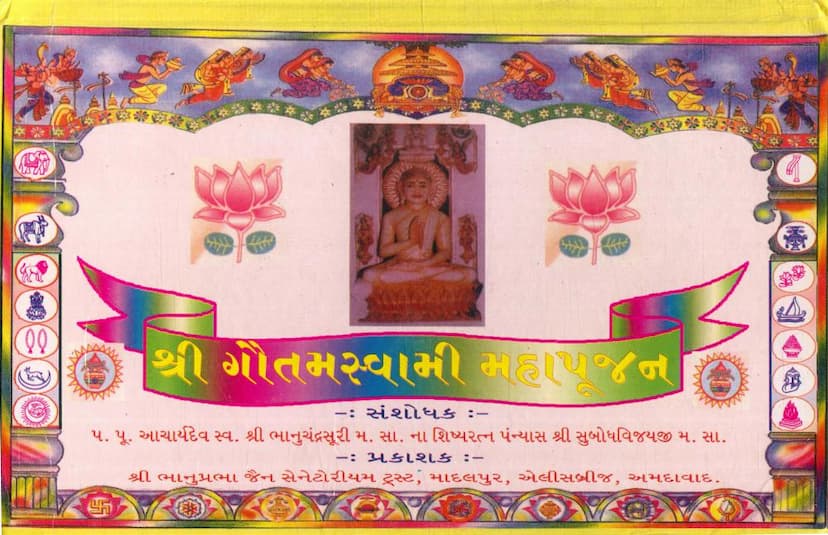Gautamswami Mahapoojan
Added to library: September 1, 2025

Summary
This document is a comprehensive guide for performing the "Shri Gautamswami Mahapujan," a significant Jain ritual dedicated to Gautamswami, the chief disciple of Lord Mahavir. It is authored by Punyasurishvar Shri Subodhvijayji M.S. and published by Shri Bhanuprabha Jain Sanatorium Trust.
Here's a breakdown of the content:
I. Introduction and Dedication:
- Title and Authorship: The book is titled "Gautamswami Mahapoojan" and is authored by Punyasurishvar Shri Subodhvijayji M.S., a disciple of the esteemed Acharyadev Shri Bhanuchandrasurishvarji M.S.
- Publisher: Shri Bhanuprabha Jain Sanatorium Trust, Ahmedabad.
- Purpose: The text is presented as a way to honor and worship Gautamswami, described as a "Mangal Vibhuti" (auspicious entity) and an embodiment of compassion and universal well-being. It aims to provide a structured and detailed method for performing a special worship of him.
- Inspiration: The publication was inspired by the teachings of the late Acharyadev Shri Bhanuchandrasurishvarji M.S. and meticulously compiled by Shri Mafatlal Fakirchand Shah (Dabhoiwal) and Mukeshkumar M. Shah.
- Significance of Gautamswami: Gautamswami is highlighted as the first Ganadhar (chief disciple who organized the teachings) of Lord Mahavir. He is revered for his infinite spiritual powers (Anantalabdhi Nidhān), wisdom, compassion, and his role in spreading Jainism. His name is considered auspicious, and remembering him is believed to bring well-being. The text draws parallels between Gautamswami and the mythical wish-fulfilling entities like Kamadhenu, Kalpavriksha, and Chintamani.
II. Structure of the Mahapujan (Ritual Sections):
The book outlines a detailed sequence of rituals and prayers, categorized into several "valays" (circles or sections):
-
Preliminary Rituals (Pages 3-4): These steps focus on purifying the self and the environment before the main worship. They include:
- Salutations and praises of Lord Mahavir and Gautamswami.
- Self-purification: Tilak (forehead marking), purification of the soul through "Iriyavahiya Vidhi" and other rituals, purification of the body, heart, and the burning of sins.
- "Nyasa" rituals: Sakalikaran (incorporating seed syllables), Panchang Nyasa (placing divine energy in body parts), Karanyasa (purifying fingers), Vajrapanjar (protective armor scripture), and Chotikan yas (dispelling negative forces).
- Worship of guardian deities (Kshetrapal Dev), Raksapotli Vidhan (amulet ritual), Peethasthapan (establishing a seat), and Yantra/Pratima Sthapan (installing a diagram or idol).
- Invocation of Guru Gautamswami using Mudras, Sankalp Vidhi (vow-making), Guru Smaran (remembering the guru), and worship of presiding deities.
- Recitation of Gautamswami's Ashtak (eight-verse praise).
- This section concludes with the completion of the preliminary rituals before the main Yantra (diagram) worship.
-
Yantra Puja (Main Worship - Page 5): This is the core of the Mahapujan and is structured in concentric circles or layers:
- First Circle: Worship of Shri Gautamswami with Ashtaprakari Puja (eight types of offerings).
- Second Circle: Recitation of specific prayers and stotras (hymns).
- Third Circle: Recitation of verses praising his glory.
- Fourth Circle: Chants and devotional singing (Dhun).
- Fifth Circle: Worship of the ten Ganadhars, 28 Ladhhipad (powers), 8 Mahasiddhis (great accomplishments), and 9 Nidhis (treasures).
- Sixth Circle: Worship of 16 Vidyadevis (goddesses of knowledge).
- Seventh Circle: Worship of 45 Agamas (Jain scriptures).
- Concluding Rites: Recitation of stotras, group chanting, Aarti (worship with lamps), Shanti Kalash (peaceful offering), Mangal Deep (auspicious lamp), Visarjan (farewell), group Chaitya Vandan (temple salutation), and Kshama Prarthana (prayer for forgiveness).
III. Detailed Rituals and Mantras (Pages 10-98):
The bulk of the document details the specific prayers, mantras, mudras, and explanations for each ritualistic step. This includes:
- Philosophical Underpinnings: Explanations on the importance of devotion (Bhakti Yoga), the concept of Panch Parmeshthi (five supreme beings), and the efficacy of worshipping divine beings.
- Specific Mantras: Numerous Sanskrit mantras are provided for various purification rituals, invocations, and offerings.
- Mudra Procedures: Instructions on performing specific hand gestures (Mudras) for invoking and establishing the deities.
- Worship of Deities and Scriptures: Detailed sections on worshipping Gautamswami, Lord Mahavir, the ten Ganadhars, various Ladhhis, Siddhis, Nidhis, Vidyadevis, and the 45 Agamas.
- Hymns and Prayers: Includes stotras (hymns) composed by various Acharyas, Ashtak (eight-verse praises), Dhun (chants), and Aarti (worship with lamps).
- Biographical Information: Brief biographies of Acharyadev Shri Bhanuchandrasurishvarji M.S. and Gautamswami are included, highlighting their lives, achievements, and spiritual significance.
- List of Required Materials: A detailed list of all the items needed for the Mahapujan is provided (pages 99-101).
- Order of Worship: A sequence for the "Uchhamani Lit" (offering of items) for different parts of the worship is given.
IV. Appendices and Supporting Information:
- Glossary of Terms: Explanations of key terms like "Ganadhar," "Ladhi," "Riddhi," "Siddhi," "Agama," and "Tapasya" are provided.
- Tapasya (Penance) Descriptions: Details of various fasts and penances associated with Gautamswami and Lord Mahavir, such as Mahavir Tap, Gautam Padgho Tap, Gautam Kamal Tap, and 28 Ladhi Tap.
- Dohas (Couplets): Devotional couplets praising Gautamswami and other Jain figures are included.
- Aarti and Mangal Deep: Instructions for performing Aarti and Mangal Deep rituals.
- Chaitya Vandan and Visarjan: Procedures for saluting the deities and concluding the ritual.
V. Overall Tone and Significance:
The book is written with deep reverence and devotion. It emphasizes the importance of faith, purity, and dedication in spiritual practices. The Mahapujan is presented as a powerful means to attain spiritual merit, overcome obstacles, and achieve one's desires. The detailed instructions ensure that the ritual can be performed correctly and effectively.
In essence, "Gautamswami Mahapoojan" is a practical and spiritual guide for Jain devotees to connect with and venerate Gautamswami, seeking his blessings and guidance on the path to spiritual liberation.